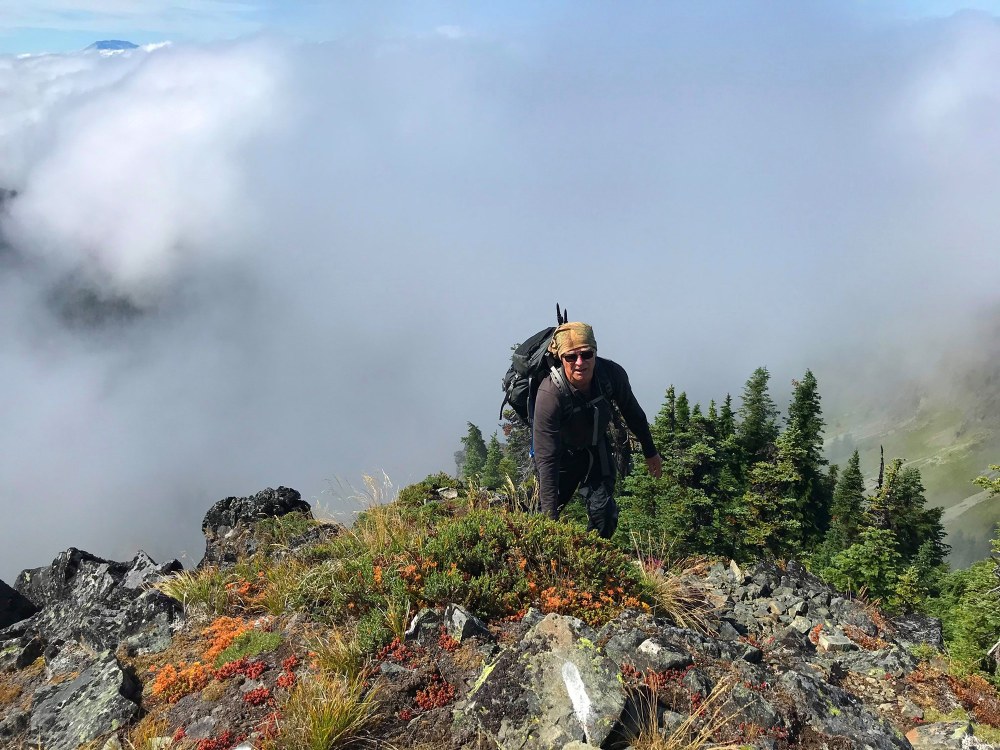
Neal Kirby and his sprightly crew were the first to attempt Mt. Baker via Coleman Glacier last season after a washout added nearly ten miles to the climb. Being the first, they had the coveted and grueling responsibility of kick stepping and trail breaking through miles of fresh, untraveled snow. Black Buttes basecamp — their intended resting stop for the night — was just in sight when ominous clouds enveloped the mountain. With the warning flashes of fast-approaching lightning, no one was in the mood to become a hillside’s electrical conductor. They retreated to treeline and set up camp for the night.
The following morning, Neal awoke to the weight of sore legs and an apprehension for the 16 more miles that lay ahead. He was the slowest of the group, which isn’t saying much considering his counterparts — Becky Nielson, Jake Fagerness, and Adam Clarno — were known for their speed. Reluctantly, Neal bowed out of the climb, which was the second alpine climb this group had organized together. Their first was a successful summit of Mt. St. Helens, intentionally postponed so it could take place a few days after Neal’s birthday.
Very few birthday wish lists include summiting a volcano, let alone all of Washington’s five in one season. For those that do, hardly any are made by folks who remember when Manila hemp ropes and oval-shaped steel carabiners were in style. Unless you’re Neal, who, at the age of 70, was on a mission to prove that the alpine still holds a place for old-timers.
A slow journey to the alpine
Watching Neal trudge up the steep slopes of a ridgeline, glissade down a volcano for three miles, or car camp at trailheads to catch a sunrise summit, you might think he was born in the mountains; but surprisingly, he only found a home above treeline nine years ago.
Neal’s exposure to the outdoors took a more do-it-yourself approach than most. Divorced with four children and only a bartending income, his mother, though supportive, didn’t have the finances for outdoor adventuring. So Neal took backcountry education into his own hands. First was downhill skiing. As a teen, he saved enough paper route earnings to purchase his own gear and bus passes to Stevens Pass where he bypassed the cost of lessons, taught himself to ski, and miraculously avoided any broken bones. At the age of 14, an irresistible urge to be outside grew even stronger after his grandmother took him on a road trip to various Utah national parks. The geological novelties and starry skies inspired him to dive deeper into the backcountry. With just a tent, a sleeping bag, and his intuition, he hit the trails. “I didn’t know what the Ten Essentials were at the time,” Neal said. “I’m surprised I survived 30 years of backpacking.”
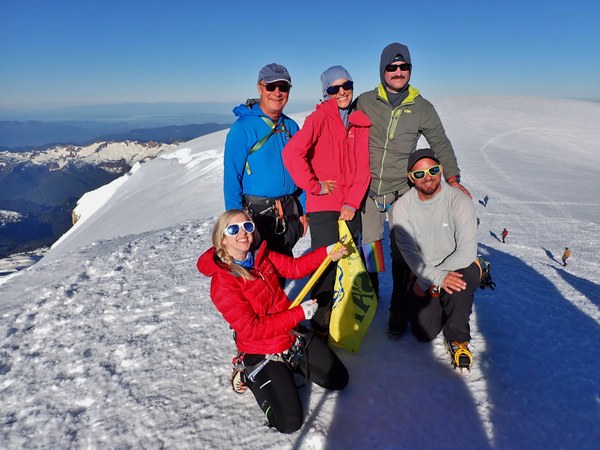 Climb leader, Carly Gintz, playing ice axe guitar for Neal and the OSAT summit team on Mt. Baker, 2023.
Climb leader, Carly Gintz, playing ice axe guitar for Neal and the OSAT summit team on Mt. Baker, 2023.
The outdoors were Neal’s playground, but it took him a while to feel comfortable elevating his adventures from lowland trails to the higher alpine. It wasn’t until after retirement that Neal came to the world of mountaineering through One Step at aTime (OSAT), an organization that connects folks in recovery to a sober community through outdoor activities such as alpine climbing. His first volcanic summit was a graduation climb of Mt. Baker followed by Mt. Rainier, where he and his group were subjected to what Neal described as the coldest time of his life in unpredicted blizzard-like conditions.
Fortunately, Neal has an aptitude for withstanding precarious environments. The cold didn’t scare him off, and the following year he joined The Mountaineers to enroll in our Basic Alpine Climbing Course. It was at this point that he realized how accessible mountaintops are – if you’re willing to take the time to reach them. “Most are just longer, steeper hikes,” Neal said. “I had it in my head that there was something more difficult or mysterious about mountaintops. I didn’t know that’s where I belonged.”
A need for speed
Since joining The Mountaineers, Neal has served as Olympia Branch Chair, been recognized as a five-year Super Volunteer, and on occasion helps lead and instruct for our Alpine Scrambling and Climbing programs. His feet have tasted more than just Washington’s peaks, including summits of Kilimanjaro, China’s Yellow Mountains, Tasmania’s Acropolis, and Guatemala’s Acatenengo.
Neal’s experiences in the mountains have changed his life, but he has also discovered that people often value speed as much as they value summits. As Neal’s years increase, so, too, does the difficulty to get accepted onto alpine climbs. Although speed is often quoted as the determining variable for incompatibility, Neal was starting to feel the effects of his age. In the backcountry, it wasn’t difficult to notice that those going a lot faster were also a lot younger. “I was older,” Neal said, “and speed is an issue. So part of the reason why I wanted to summit all five volcanoes at 70 was to show despite my age I could climb, and climb well enough to get all volcanoes done in one summer.”
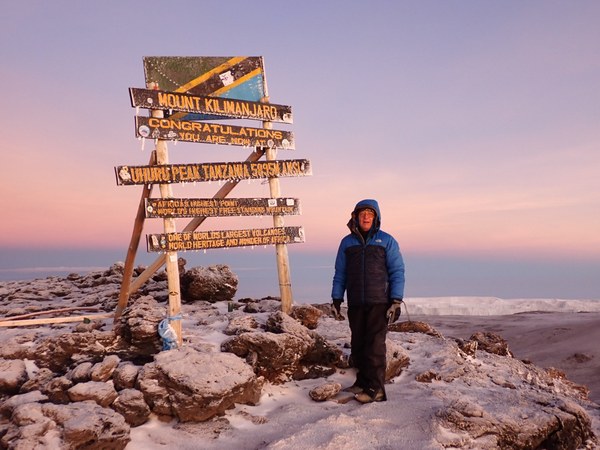 Neal on the summit of Mt. Kilimanjaro, Thanksgiving Day, 2022.
Neal on the summit of Mt. Kilimanjaro, Thanksgiving Day, 2022.
Compared to most outdoors people, Neal is by no means a slow climber, but as an older climber, it takes more conditioning to keep up with the youthful Lightning McQueens that populate the mountaineering community. He can’t control his age, but he can control his strength, which is why he developed a thorough training plan that enables him to "enjoy a climb without feeling held back by fitness levels." To avoid the risk of injury that comes with intense training, Neal begins training with mellow hikes and gradually introduces more mileage, pack weight, and elevation until he can complete the 12-mile and 5,000-foot climb of Mt. Elinor. To expand lung capacity and build his diaphragm, Neal swims on his back for an hour with large flippers. To build strength, he does extended stretching at home, and weight lifting and yoga at the gym. “I've never been able to develop a really great speed but I have a good pace,” Neal shared, and what he lacks in timeliness he makes up for in grit. He may not be setting any records, but he wasn’t going to let a pesky thing like age hold him back.
Rising to the challenge
The alpine is not the only place where Neal has had to fight against the odds. As a young boy, he had to navigate family financial instability, abusive older siblings, and dysfunctional parents. Speaking about his childhood, Neal said it was “a lot like being in a chicken coop where everything was just kind of running wild.” After he started working on a farm at age 11, his father would “borrow” his earnings. In his sophomore year of high school, Neal sought foster care, and at the age of 16, he found alcohol and started racking up his fair share of blackouts, muddled memories, and difficult relationships.
While some people can drink for years before developing an addiction to alcohol, Neal believes one can inherit alcoholism and dopamine's overreaction to it. It wasn't long before Neal’s drinking was like Russian roulette, not knowing when he might go over the top. “The insane thing about alcoholics is they desperately want to drink normally,” Neal shared. “They try over and over and over again, despite the same disastrous results. It takes hitting a bottom for it to ring through that maybe drinking isn’t working for them.”
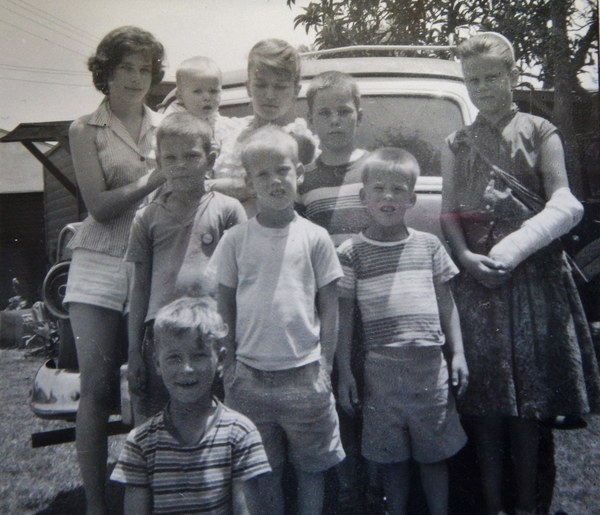 Neal kneeling in front of his mother, age 29, and his seven siblings, born between 1947 and 1959. Photo by Neal's father, Don Kirby.
Neal kneeling in front of his mother, age 29, and his seven siblings, born between 1947 and 1959. Photo by Neal's father, Don Kirby.
At 31, Neal was arrested for the fourth time. The judge gave him the option of jail time or deferred prosecution. Recently married, he had just started teaching and had a baby on the way. For Neal the choice was obvious. “I had things I cared about that I didn’t want to lose,” he shared. So he accepted deferred prosecution and outpatient treatment. Neal had a breakthrough when he realized that “alcoholism is not how much you drink, what you drink, or how often you drink, but what it does to you when you do drink and whether or not it’s impacting other things you value such as family, finances, work, or education.” With lessons learned through outpatient treatment and the encouragement of fellow recovering alcoholics in support groups, sobriety took hold.
After getting sober and starting his career, Neal poured his heart into fighting systemic discrimination in Washington’s schools and educational finance system. As a child, the classroom had been his refuge from the consequences of alcohol, poverty, and his family’s poor emotional foundation. “But I never forgot my roots,” Neal said, and until retirement he worked hard to provide safe and challenging learning environments to lower-income students. While working as principal, his school achieved “exemplary” academic ratings from the state despite 70% poverty rates. Not afraid of holding truth to power, he became a whistleblower for the theft of Medicaid money by the Centralia School District. Of all his educational accomplishments, he is most proud of founding and chairing the Committee for Levy Equalization, which, over 30 years, secured four billion dollars for poorer schools in Washington. Even before entering the alpine, Neal was overcoming mountains.
What a recovering alcoholic can teach you about mountaineering
One of the most impactful lessons Neal learned on his path to sobriety was how to manage his reaction to life’s unpredictability. Neal uses the Serenity Prayer as a framework for going through life, which asks people to accept what they can’t control and have the courage to change what they can. It took Neal a while to learn the former, especially as it applied to his personal life. In reaction to childhood family dysfunction and poverty, he controlled finances and nitpicked how a family should operate. “That childhood anxiety just hung over me,” Neal said. “I tried to micromanage everything to be the kind of family I didn’t get when I was growing up, and that didn’t work too well in a marriage.”
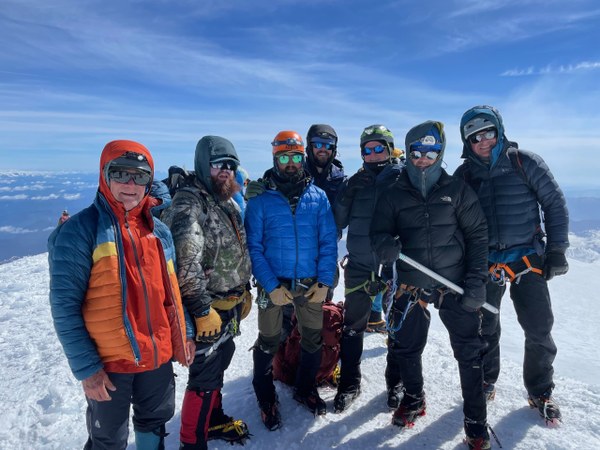 Neal (left) with OSAT summit leader, Bill Link, and team on Mt. Rainier, 2023.
Neal (left) with OSAT summit leader, Bill Link, and team on Mt. Rainier, 2023.
The mountains, however, were a wake-up call. A lot can happen that’s beyond your control. Weather can creep in unnoticed, routes become obscured, intended hiking partners have to cancel. While you can’t control the mountain, you can control your response to it. Neal emphasized that in recovery — and in the mountains — you must train yourself not to react to your circumstances in a way that makes matters worse. You must learn how to keep yourself calm, think clearly during stressful situations, and examine not only your needs but the needs of the people around you.
Many in the mountaineering community may be obsessed with speed, but that doesn’t keep Neal from hopping on climbs with folks that move at challenging pace. Fortunately, he has found a community of climbers that support his pursuits to test his limits. “The Mountaineers and OSAT give you an ethic in the wilderness of being responsible for each other and helping take care of one another,” Neal said. During a Mountaineers climb of Foss and Pinnacle Peaks last year, Neal worried he was holding the group back. His climbing partners replied that they were simply happy for any opportunity to be outside enjoying the views. Looking back on last summer’s climbs, Neal recalled fondly how attentive Becky, Jake, and Adam were to his needs, checking in and acknowledging his level of improvement throughout the season. “All three of them were very supportive,” Neal shared. “I think they thought it was kind of cool climbing with an old guy on some volcanoes.”
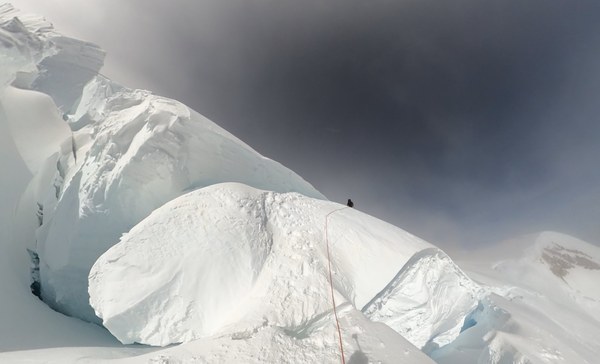 Neal en route across the bergschrund from the Emmons Glacier to the Winthop Glacier on Mt. Rainier during an OSAT climb. Photo by Kevin Forsyth.
Neal en route across the bergschrund from the Emmons Glacier to the Winthop Glacier on Mt. Rainier during an OSAT climb. Photo by Kevin Forsyth.
Embracing old age in the mountains
Neal succeeded in summiting all five Washington volcanoes last summer and has now climbed Rainier six times since qualifying for Social Security.
He completed Baker on the Easton Glacier route during a formal OSAT climb. Following that, he summited Rainier on the Emmons route during a formal OSAT climb, and Adams with an informal OSAT group. Although Becky, Jake, and Adam wanted to accompany Neal on his five summits, they were unable to make it work due to inclement weather, conflicting schedules, and all other misalignments that make backcountry planning difficult. They did, however, come together for Neal’s favorite climb: Glacier Peak, during which Neal had to lug 40 pounds over 16 miles and 6,000 feet of elevation gain on the first day. He described the experience as the best climb of his life, and was just six miles short of finishing the 36 mile climb in two days.
This year marks 40 years of sobriety for Neal. As a volunteer leader with OSAT and The Mountaineers, he’s both an inspiration for sobriety and for the possibility of climbing in old age. “A number of older mountaineers have shared that they would have kept climbing bigger peaks but feared holding back the teams,” Neal said. “So I wonder, how many checked themselves out of glaciated climbs too early, and how many would join a climb less focused on speed?”
With his summer-summit bucket list complete, Neal dreams of leading trips for older climbers who might appreciate a little more time to take in the views on their way to the top, such as a five-day climb of Glacier or a four-day climb of Rainier. The committed student, he remains dedicated to his training and continues to charge his way into the alpine at any speed. “I feel blessed to be in good health and still able to climb at 70,” he says.
At some point, Neal’s conditioning and strength will also enter the veil of the uncontrollable, and he’ll know when it’s time to bow out of climbing for good. But for now, he continues to hold his place in the alpine. One thing’s for sure; Neal doesn’t shy away from the unknown. Sometimes things go according to plan, and you’re rewarded with bluebird views of a snow-covered valley. And sometimes a washout adds extra mileage to an important climb that you have no choice but to try again later. The mountain will give you what it will, and you have to work with it.
This article originally appeared in our summer 2023 issue of Mountaineer magazine. To view the original article in magazine form and read more stories from our publication, visit our magazine archive.
 Skye Michel
Skye Michel